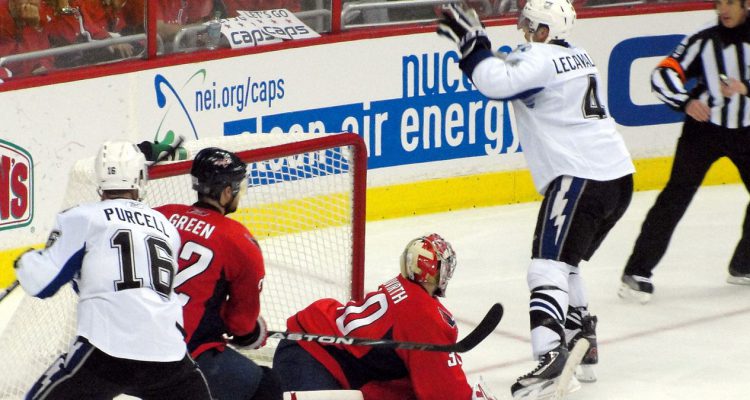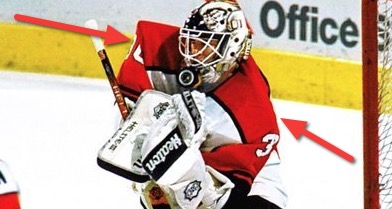By: Patrick W. Zimmerman
Sudden-death, multi-overtime hockey games are the best viewing in sports. We’re going to take that as a prior because it is incontrovertible fact. And it gets bonus points for no commercial breaks. Go ahead, change the channel in double OT. We dare you.
If OT is the best, then, logically, we should try to figure out how to get more of it. The math is simple: more OT = more awesome.
So, how do we do that? It turns out that the answer is pretty intuitive: learn to stop worrying and love defense. The lower the overall score of games during the (pretty meaningless) regular season, the more likely games are to end in ties during the (awesome) Stanley Cup playoffs. Ergo, a defensive environment results in more overtime.
Huh, so there was a redeeming quality to the Dead Puck Era, after all. It led to this:
And this:
Also this (a game so epic it merited an oral history):
There was a 70-save, 4OT shutout by Dominik Hasek (with Marty Brodeur, that slacker, only making 48 saves before allowing a goal):
And it makes games like the Easter Epic in 1987 (Pat LaFontaine beats the Capitals in Game 7 in 4OT) stand out even more, since somehow that game lasted an extra 68 minutes in an insane goal-scoring era.
Seriously, in the mid-80s, goalies played a stand-up style that looks ludicrously inefficient at stopping pucks today, standing up virtually straight and trying to kick at low shots.
The question
How does the scoring environment of the NHL affect the single greatest thing in all of sports: Stanley Cup Playoffs Overtime?
The short-short version
Scoring environment has a moderate but statistically significant effect on both playoff OT probability and OT length, particularly since the NHL and WHA merger before the 1979-80 season brought the number of playoff teams to 16.
In short: lower scoring during the regular season leads to a higher probability of OT games and longer OT games in that season’s Stanley Cup playoffs. This holds true even though OT probability and OT length are not themselves correlated.
Note: 2019 stats are through games of 4/28, so 1-2 games into the 2nd round.
Results
We tested for a correlation between goals per game during the regular season and both OT probability and OT minutes played per OT game since the 1967 NHL expansion and since the 1980 modern 16-team playoffs. And yup, there’s a negative correlation across the board.
Goals per game to OT probability since the NHL/WHA merger:
Mouseover for details.
There are some wacko seasons (2000 and 2018 had way fewer OTs than expected, and 1993 was bonkers in that respect), but for the most part seasons line up nicely for a nice negative correlation of -0.50. That is, for about every additional goal per game that is scored in the regular season, playoff OT probability for each game drops ~3.2%.
Under the modern playoff format, then, of between 60 and 105 games, that translates to a difference of about 2-3 Stanley Cup OT games per additional goal per game in the regular season.
Goals per game to OT length since the NHL/WHA merger:
Mouseover for details.
The effect is similar for OT length on a per-game basis. For every additional goal scored per game in the season, we are robbed of 2.2min of OT per game. Which is a crime.
Since the 1968 expansion:
Going back further, to when the NHL doubled in size, the effect is a still there, but is weaker, reflecting the extremely different styles of play and almost unrecognizable talent pool (no Europeans, few Americans).
Mouseover for details.
Mouseover for details.
Wondering how these have changed over time? That’s what line charts are for. You can see a steady climb in goals per game in the NHL from the expansion until the mid-1980s, peaking at over 8 goals per game in 1981-2. Which seems insane. Then, once goalies figured out that they can move their blockers and gloves faster than their legs, scoring steadily dropped through the Dead Puck Era, bottoming out at 5.24 in 2002, just before the lockout gave the league a chance to start putting some limits on holding, hooking, and goaltender pads. Which resulted in a mild correction, though nowhere near the track meets of the early Gretzky days.
Mouseover for details.
Mouseover for details.
Conclusions
The answer is clear. The regular season needs to be sacrificed to bring us closer to our ultimate goal, more sudden death.
Bring back the Garth Snow-style giant goalie pads!


No Comments on "Want more Stanley Cup OT? Start cheering for more defense"